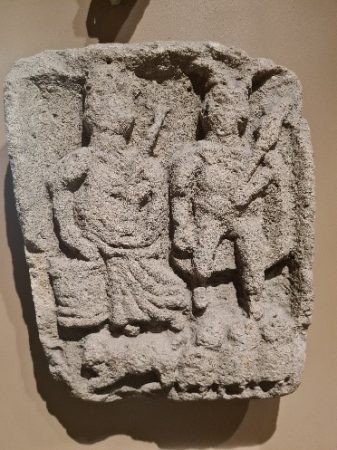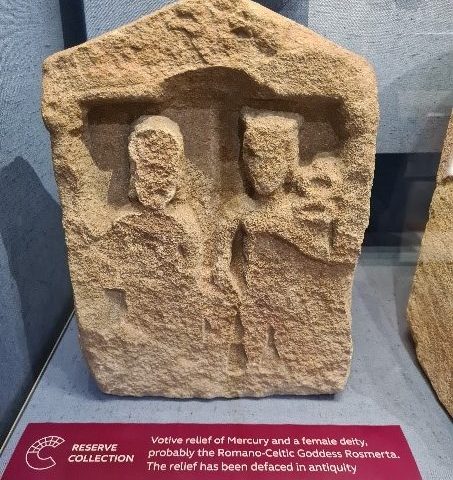Blog post by Juliette Morton
Have you heard of the Celtic goddess Rosmerta?
Neither had I.¹

Figure1. Rosmerta and Mercury at Corinium Museum
And yet the archaeological record is far more extensive than that for the goddess Cuda who has recently captured the imagination of local artists, including myself.
Rosmerta is attested in iconography and statues from across the Gaulish world on both sides of the Rhine and in Britain, particularly in the south west and around what is now Gloucestershire. There is a statue of Rosmerta with her consort Mercury in the Corinium Museum that was defaced in antiquity but which still shows the outlines of the Celtic goddess and Mercury with his caduceus, a staff with two entwined snakes.

Figure 2. Mercury, Rosmerta and the Genii culculatti at Bath
On the relief held at the Roman Baths we get a clearer picture. Dressed in a pleated robe, Rosmerta has her source of plenty, a wooden bucket, and she is accompanied by the horned Mercury and three genii culculatti, hooded Celtic spirits which possibly (we do not / cannot know) represent three levels of the cosmos and signal the centrality of triplism in Celtic ritual.
Several stone images of Rosmerta and Mercury were found around Gloucester, including one at Shakespeare Inn which clearly shows Mercury with his purse, symbol of wealth and commercial success, his caduceus and cockerel. Rosmerta is depicted with a staff, ladle and wooden bucket – commonly thought to be a butter churn or, as suggested by Miranda Aldhouse-Green, an object harking back to the bucket burials for high status Britons that took place in the century before the Roman invasion². Either way, it is a representation of prosperity and plenty.

Figure 3. Rosmerta and Mercury, Shakespeare Inn, Gloucester
There is so much we do not know about Rosmerta. The internet is scattered with unreliable research, supposition and the freewheeling extrapolation of new age spiritualism. But we do know that Rosmerta’s name is from the Gaulish, meaning ‘the good provider.’ She is a goddess of plenty and care, kindness and prosperity, abundance and fertility. While Rosmerta often appears with Mercury, many icons exist of her alone – she was a powerful goddess in her own right. Depictions of Rosmerta and Mercury show no hierarchy between them. Together they represent a harmonious partnership of equals and a bringing together of the Celt and Roman worlds.
‘Defaced’ was a word that stayed with me long after my recent visit to Corinium Museum. To ponder the impulse behind the (literal) de-facing of this Romano-British couple was to consider not just the violence in the physical act of hacking off the features that had been carved in stone but also the shifting power and geopolitical dynamics of European history.
The notion that Rosmerta and Mercury could be representative of such a ‘modern’ concept as equality has also stayed with me. I held the image and idea of Rosmerta in mind in the days following my Museum visit, asking nothing of it, patiently waiting to see what, if anything, emerged.
Unbidden, the phrase ‘compassion fatigue’ entered my 21st century mind – very much tongue in cheek in tone and slightly sardonic. What also came was an idea of Rosmerta as a figure who absorbed the fear of lack that was felt by those who worshipped her and physically overwhelmed (buried, lost sight of) her with their offerings.
Rosmerta’s generosity may be endless but perhaps in our thinking about her across the millennia we have overlooked the bigger lesson that she teaches about the value of harmony: with the land on which we live and the people that we love. That rather than a gluttonous demand for abundance, we might seek a more balanced give and take.
This alternative reading of Rosmerta is a kind of re-imagining/image-ing or re-facing if you will, and it is what I hear perhaps because this is what serves us in the present moment. Ever the prescient provider, this reading of Rosmerta is the crack in our fragmented understanding of her history from which my poem grew.
Rosmerta
after Diane Seuss
Prosperity deranged me, shoved me off. All that rotting
flesh at my feet, the rancid fat I had churned for millennia.
Blue bottle flies were warriors with their metallic,
their faceted eyes, storming my coordinates to throw up.
I couldn’t break out of this glut. The supplicants
pushed on with their need for bifolds and bubble butts,
competing for potential. My arms split apart with the gifts.
But see the snakes that curl round the wand open their mouths
in a way that transmutes into vulva and phallus: more
re-enchantment than dumb instinct. More groundwater rising.
Mercury and I hold the quicksilver truth of a mirror balanced
around us. See that this is the worship. Love is not battle or
surrender. The statue is not the woman, it is not his body the statue
is false icon. A history of how we have given.
¹ Not the Harry Potter character!
² Miranda Aldhouse Green Sacred Britannia: The Gods and Rituals of Roman Britain (London: Thames and Hudson, 2018)










